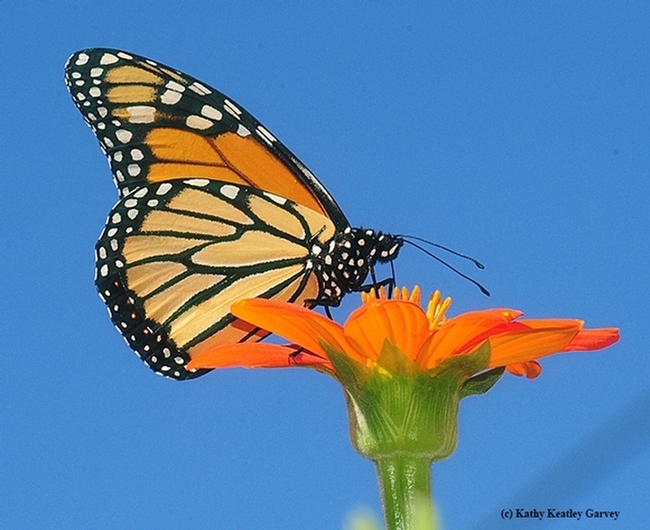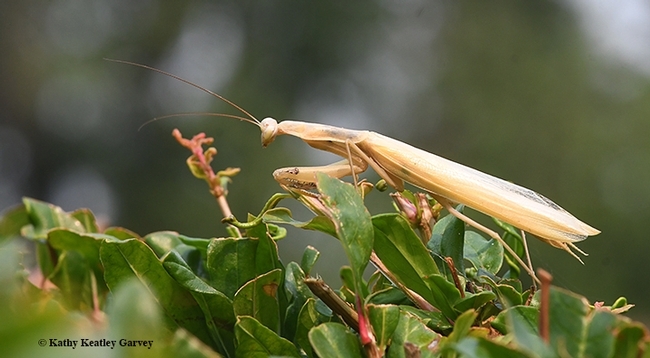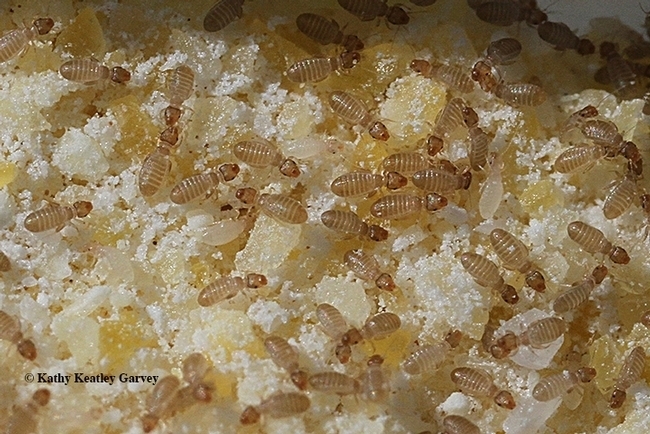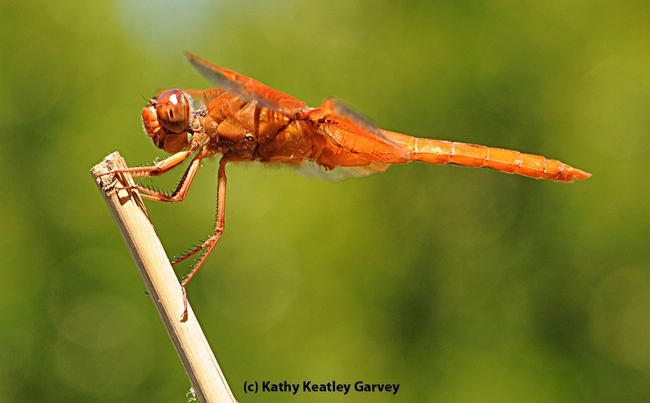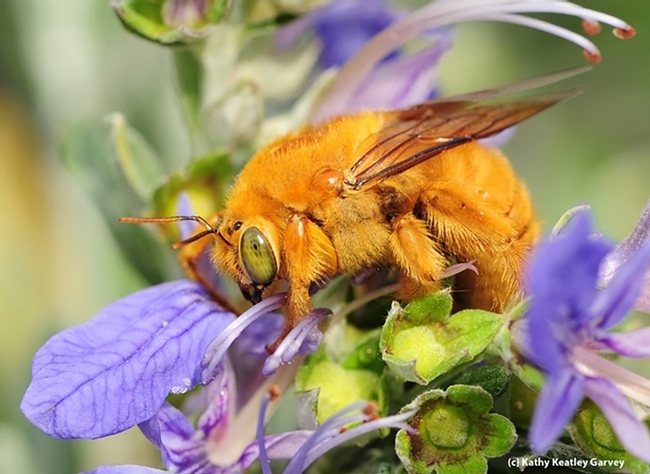- Author: Kathy Keatley Garvey
Butterflies and moths totally fascinate entomologist Jeff Smith, the 32-year volunteer curator of the Bohart Museum of Entomology's Lepidoptera collection.
Smith loves talking about them, engaging folks face-to-face, and answering their questions. He is a fixture at the Bohart Museum open houses and other events, including the UC Davis Biodiversity Museum Day and the annual UC Davis Picnic Day.
But this year's Picnic Day, the 107th annual, went virtual due to the COVID-19 pandemic. Not to be deterred, Smith hosted a one-hour Zoom session. "Mimicry in the Butterflies and Moths with Jeff Smith," now available online on YouTube at https://youtu.be/8ZccezxhhK4.
Smith prefaced his talk by recommending the 375-page book, Insects and Other Arthropods of Tropical America by Paul E. Hanson and Kenji Nishida. "I didn't write it," he added, "and we (Bohart Museum) do not sell it (in the gift shop)." The book is an introduction to arthropods in North America--not just butterflies and moths but beetles, wasps, flies, true bugs and others.
"I've always been fascinated by the mimicry of butterflies and moths," said Smith, who won a 2015 Award of Distinction from the UC Davis College of Agricultural and Environmental Sciences for his volunteer service (see news story). "I've had the opportunity to make 10 to 12 trips to South and Central America. What I found there are great examples of how they can mimic each other or other things in order to survive."
Smith defined mimicry as "the close resemblance of an animal to some other animal, some other a plant or some inanimate object." Müllerian mimicry, named for Johann Friedrich Theodor "Fritz" Müller, is "where two or more species have similar appearances as a shared protecting device," Smith told this audience. "Batesian mimicry, named for Henry Walter Bates, is the resemblance of an edible species to other species that are noxious and avoided by predators."
"The monarch and the viceroy are good Batesian mimics," Smith said, "because until recently, it was believed that the monarch is distasteful and slightly toxic and that the viceroy was an edible species but it looked so much like the monarch that it was protected as well. It turns out--I don't know if somebody ate it or if they just tested the chemicals in the insect--but it turns out the viceroy is also a distasteful and toxic butterfly so we've now switched this from Batesian and mimics to Müllerian mimics, but the fact is, that they they look very much alike. Predators may have tried one and didn't care for it so now they leave alone anything that kind of looks like that."
"In order for mimicry to work," Smith pointed out, "the two different species need to be living in the same general habitat as each other. So if the monarch lived in Asia and the viceroy lived in North America, predators would never learn to associate these things with each other, and with that bad experience of trying to eat them."
"It's also important, I think, for us to understand that everything about every insect, in particular every butterfly and moth, that every pattern, every color, and every shape is meant to protect it. These things have evolved over many millions of years and that's what's worked for them."
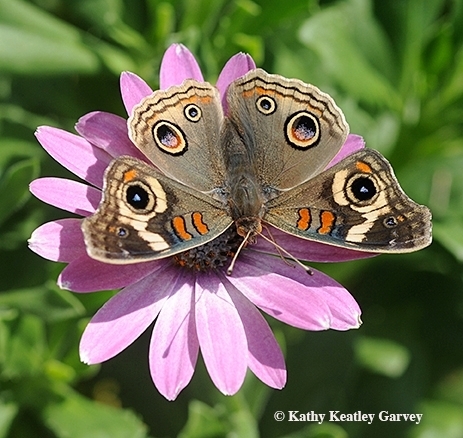
Smith also drew attention to predator avoidance of butterflies with eye spots, such as the buckeye butterfly, Junonia coenia, and the owl butterflies, Caligo. Some bumble bees have beetle and fly mimics, including the longhorned wood-boring beetles and robber flies. "They look like something that could sting and they get protection from that."
Smith estimated that of the 17,500 described species of butterflies in the world, about 750 of those occur in North America. "However, in North America there's 160,000, easily, species of moths. Moths are far more numerous than butterflies, and in particular, with the little tiny moths, it's estimated by experts in those groups, that at least 90 percent of the species still have not been described. They are sitting waiting for someone to identify them and give a name to them. So if anybody is interested in insects and wondering if there's still something left to do, the answer is absolutely yes."
The Lepidoptera curator also discussed host plants: how milkweed offers toxicity to monarch caterpillars, and how passionflower offers toxicity to Gulf Fritillaries. "And they sequester it. They use it for their own defenses. It's kind of curious that in the monarch butterflies, the male may pass on some of those toxic chemicals to the female when they mate, and the female then stores those chemicals into the eggs, and gives the eggs some level of protection once they're placed on a plant. So they call it a nuptial gift."
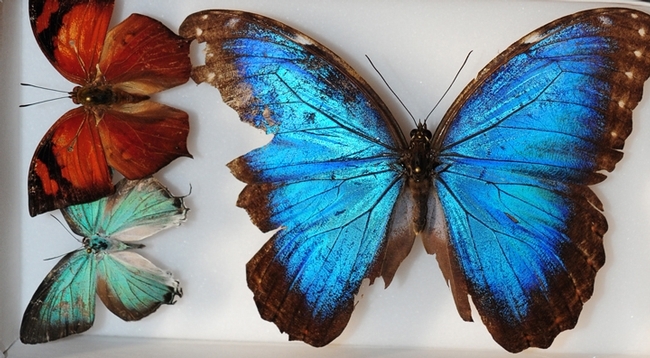
Tabatha Yang, the Bohart Museum's education and outreach coordinator, helped field the questions. Smith said Lawrence Allen's book, Butterflies of the Western States, available in the Bohart Museum's online gift shop, is a good resource.
When asked his favorite butterfly, Smith acknowledged that "it's kind of hard to pick a favorite butterfly. It may very well be, I mean as far as the thing that gets me the most excited, the big Morphos, the big blue Morpho butterflies that you find in tropical America. There are about 30 different species. They're almost all brilliant metallic blue on top, with wing spans of four to six inches across, and brown on the underside so they're camouflaged when they're landing with those wings closed. But when you see one of those fly by you, and when you're walking around in a trail in the rain forest in Central or South America, it's pretty exciting. Once in a while, it'll even land on your arm and sip the the sweat."
Many people don't want to know this, Smith said, but butterflies also feed on the nutrients in "rotten bananas, dead animals, and urine and feces." That includes human waste.
Lamenting the plunging population of monarchs, Smith advocated that folks plant milkweed and nectar sources in their gardens. Urbanization is one of the causes of the decline, he said.
The Bohart Museum, which is marking its 75th anniversary this year, is located in Room 1124 of the Academic Surge Building on Crocker Lane, but is temporarily closed due to the COVID-19 pandemic. Directed by Lynn Kimsey, UC Davis distinguished professor of entomology, it houses nearly eight million insect specimens and is the seventh largest insect museum in North America. In addition to its online gift shop, the Bohart Museum maintains a live "petting zoo" comprised of Madagascar hissing cockroaches, stick insects and tarantulas.
In 2019, UC Davis hosted the international Lepidopterists' Society's 65th annual conference. The scientists visited the Bohart Museum twice. Kimsey participated with senior museum scientist Steve Heydon; and Bohart associates retired research entomologist John De Benedictus, naturalist Greg Kareofelas, and Smith. (See Bug Squad blog)
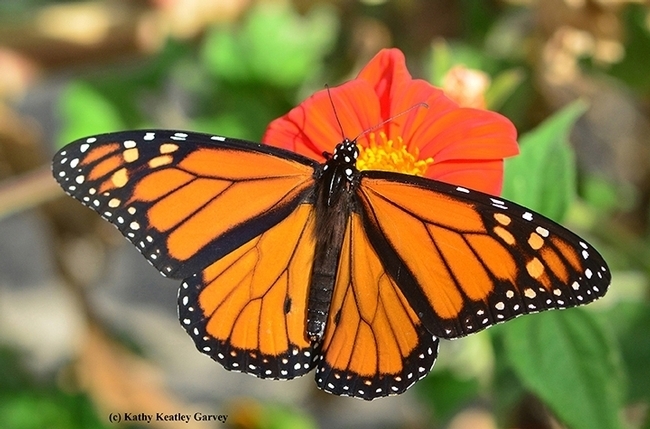
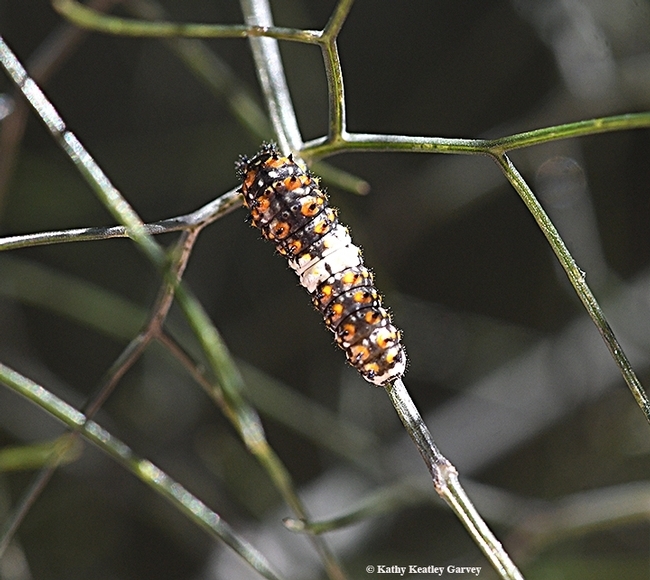
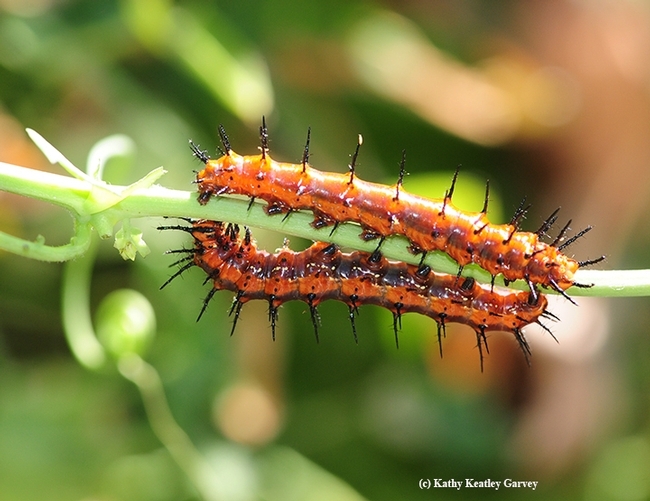
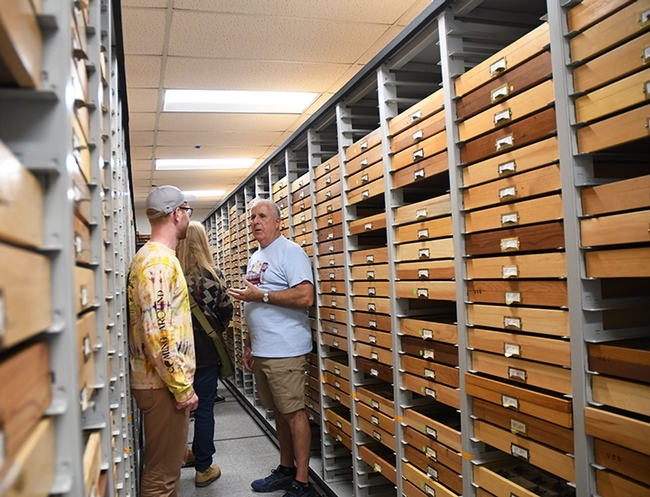
- Author: Kathy Keatley Garvey
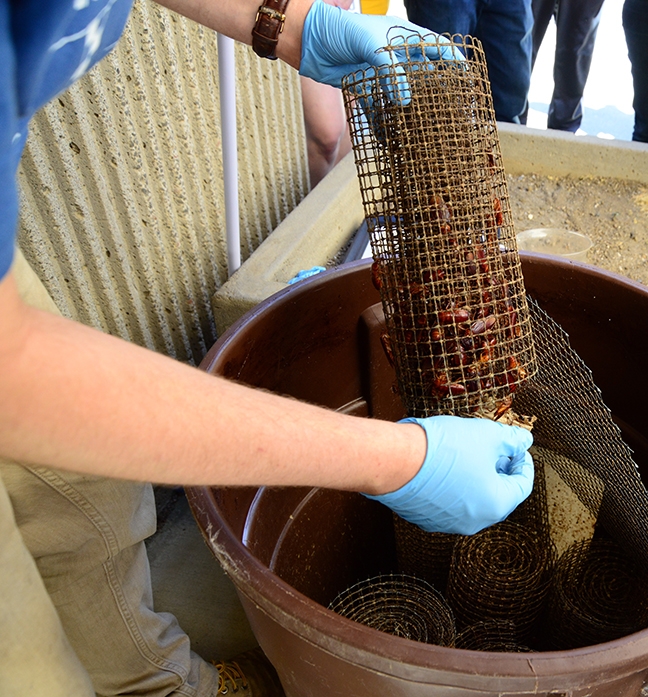
And when the 107th annual UC Davis Picnic Day goes virtual on Saturday, April 17, the insects will go virtual, too.
The UC Davis Department of Entomology and Nematology and the Bohart Museum of Entomology will be participating with virtual cockroach races and a series of talks. Among them: Bohart Museum associate and natural historian Greg Kareofelas will present a pre-recorded video on Gulf Fritillary butterflies and entomologist Jeff Smith, the Bohart's volunteer curator of the Lepidoptera collection, will deliver a live (Zoom) talk from 1 to 2 p.m. on butterfly and moth mimicry.
"For my presentation on mimicry within Lepidoptera, it will briefly mention camouflage and spend most of the time on mimicry for defense--mimics of toxic or distasteful species, mimicry using odors or sounds, mimics of snakes or spiders, and mimics of non-food materials such as bird feces," Smith said.
More events are pending.
The Bohart Museum, temporarily closed, is located in Room 1124 of the Academic Surge Building. Directed by Professor Lynn Kimsey, the Bohart Museum includes nearly eight million insect specimens, a live "petting zoo" (Madagascar hissing cockroaches, stick insects and tarantulas) and an online gift shop stocked with insect-themed t-shirts, jewlery, hoodies, books and posters.
The UC Davis Entomology Graduate Student Association is selling t-shirts on its website (including shirts featuring Roach Races), and soon will be offering face masks and stickers.
Discovering Silver Linings
This year's theme is “Discovering Silver Linings.” Despite all that has happened this year, the UC Davis community has continued to find silver linings everywhere, the Picnic Day officials reported on their website. "Our campus always strives to inspire hope and works towards a better and brighter tomorrow."

It all began, according to the UC Davis Picnic Day website, "when the University Farm invited the surrounding community to view their new dairy barn. Two thousand visitors attended, bringing picnics to complement the coffee, cream, and sugar provided by the University. Following the success of the 1909 picnic, the faculty of the University Farm continued to plan and sponsor the event until a student committee took over the task in 1912. Through the years of Picnic Day history, the event has only been canceled five times. In 1924, an outbreak of hoof-and-mouth disease among the cowherds caused the first cancellation. In 1938, delayed construction of the gymnasium, which was needed to accommodate the ever-increasing number of participants, led to a second cancellation. During World War II, the Army Signal Corps controlled the campus, and Picnic Day disappeared from 1943 to 1945. Since 1946, Picnic Day has been growing strong and now boasts an annual attendance of more than 70,000 people. This year, there will be more than 200 events on campus and an estimated 75,000 visitors attending this special event. Since 1959, the parade was extended to include downtown Davis to celebrate the fact that Davis became a separate UC campus and not just the Farm School for UC Berkeley."
This year's Picnic Day won't look like the traditional Picnic Day, but it will include insects!

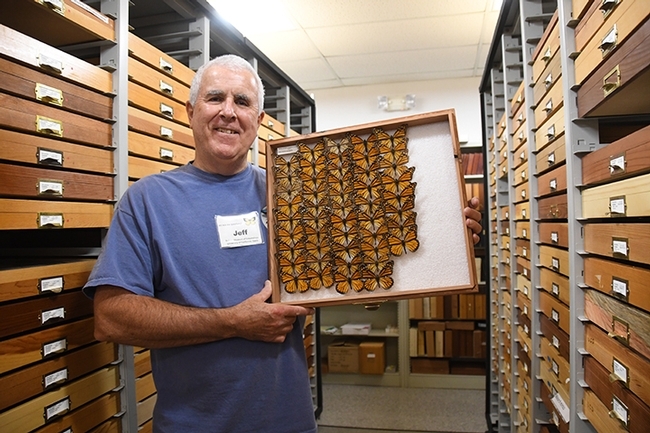
- Author: Kathy Keatley Garvey

Butterfly guru Art Shapiro, UC Davis distinguished professor of evolution and ecology, knows where they are. As mentioned in a previous Bug Squad blog, he spotted a cabbage white butterfly, Pieris rapae, on Jan. 16 on the UC Davis campus, just south of the Jan Shrem and Maria Manetti Shrem Museum of Art, located at 254 Old Davis Road.
As you probably know, Professor Shapiro always looks for rapae as part of his scientific research; he sponsors the annual Beer-for-a-Butterfly Contest to determine its first flight of the year. COVID-19 canceled this year's contest.
But did you also know that Shapiro found FOUR other butterfly species on his Jan. 16th rounds in Davis, which included Old Davis Road on the UC Davis campus, and residential Davis?
- Red Admiral, Vanessa atalanta, seen in Lot 1 landscaping
- Gulf Fritillary, Agraulis vanillae, spotted in residential Davis, north central
- West Coast Lady, Vanessa annabella, seen on Old Davis Road near the campus hotel.
- Mourning Cloak, Nymphalis antiopa, spotted on Old Davis Road
The links on the species will direct you to his amazing research site, Art's Butterfly World, and the wealth of information.
Our butterfly-spotting record so far: Zero. Zilch. Nada.
But of course, what with the pandemic and all, we haven't been out much. The 100-acre UC Davis Arboretum and Public Garden is a good place to stroll, observe and photograph. We remember spotting a Mourning Cloak in the Arboretum's Ruth Risdon Garden on Saturday, Feb. 6, 2016 on an identification sign for the silver anniversary butterfly bush, Buddleia “Morning Mist."
It was a good place to warm its wings.
Meanwhile, here are a few images of the butterflies that Shapiro saw on Jan. 16. These images were taken in the two-county area of Yolo and Solano.
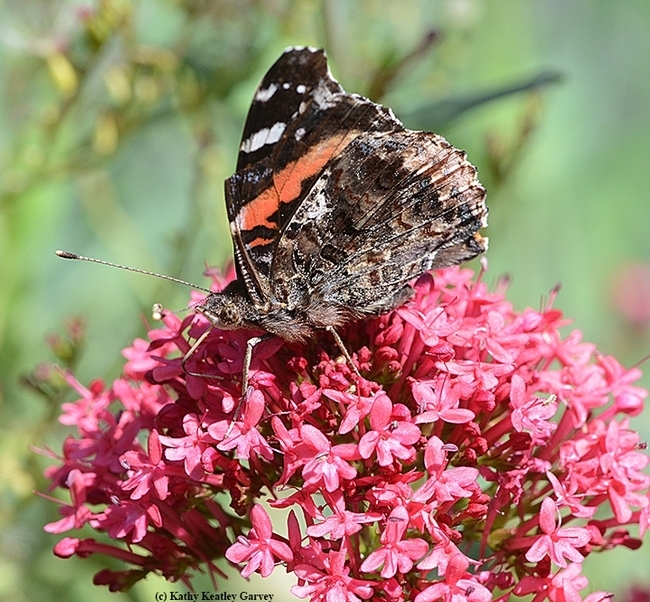
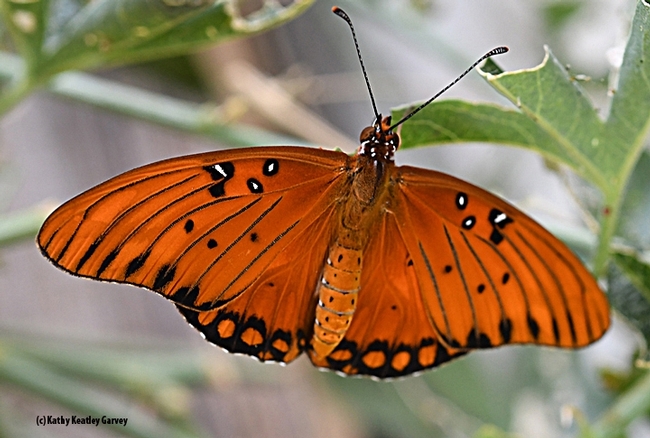
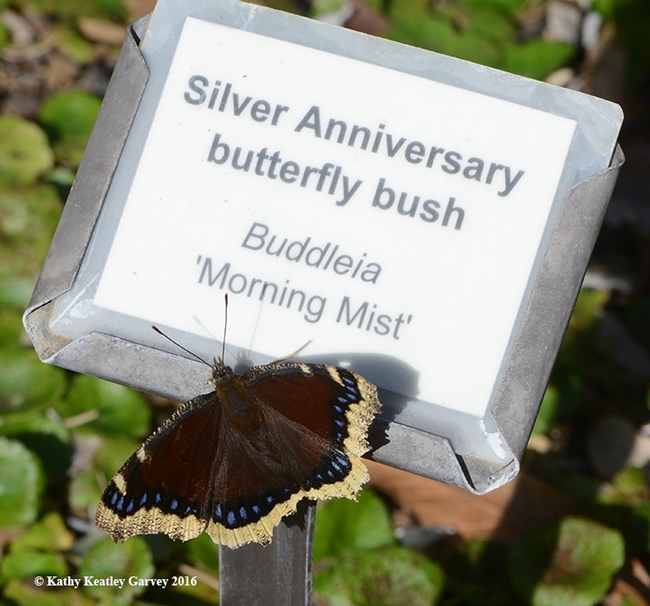
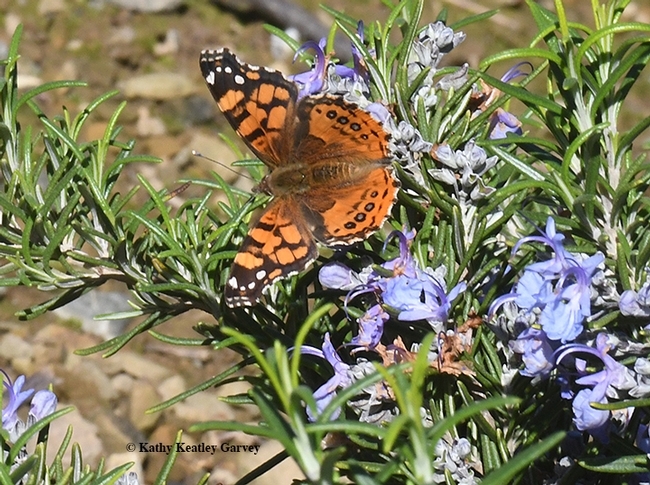
- Author: Kathy Keatley Garvey
If you vacationed at Doran Regional Beach, Bodega Bay, on a Wednesday last year (pre-COVID-19 pandemic), chances are you saw scores of dedicated volunteers pulling out the invasive ice plant, Carpobrotus edulis, along 201 Doran Beach Road. It's hard work but it's rewarding.
Wednesday was--or is--Ice Plant Removal Day. (See the Sonoma County Regional Parks website.)
C. edulis, a succulent native to South Africa, is unwanted in Bodega Bay's wetlands because it chokes out native, endangered plants and alters the soil composition. When it's removed, native plant species return as do a diversity of wanted wildlife.
Yes, nurseries sell ice plant as a ground cover because it's hardy, easy to grow, and spreads quickly. The neon pink blossoms, in particular, are spectacular. (See photo)
C. edulis, though, is as pervasive as it is pretty. It's the flora equivalent of Public Enemy No. 1.
Nevertheless, you'll see "wanted" insects foraging on the "unwanted" plants along the Doran Beach trails. We've seen honey bee and butterflies foraging on the blossoms--including a pollen-packing bee seeking nectar--a short distance from the ice plant removal site. And once we saw a Great Blue Heron snatch a vole from the ice plant growing along the Jetty Campground, Doran Beach.
Beauty and beasts are where you find them, whether they're flora or fauna or wanted or unwanted. Take a hike. Take a camera. Or, better yet, volunteer for an Invasive Plant Removal Day. The California Native Plant Society will thank you.
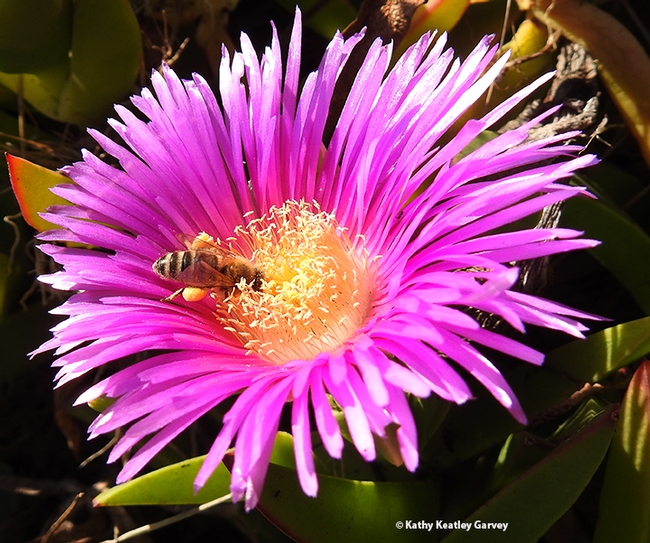
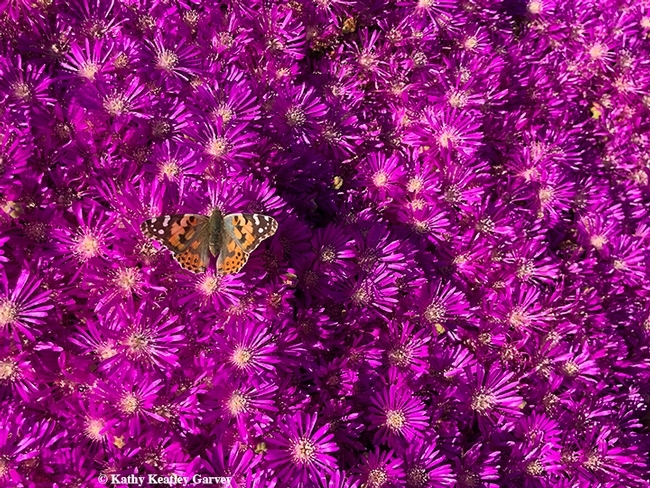
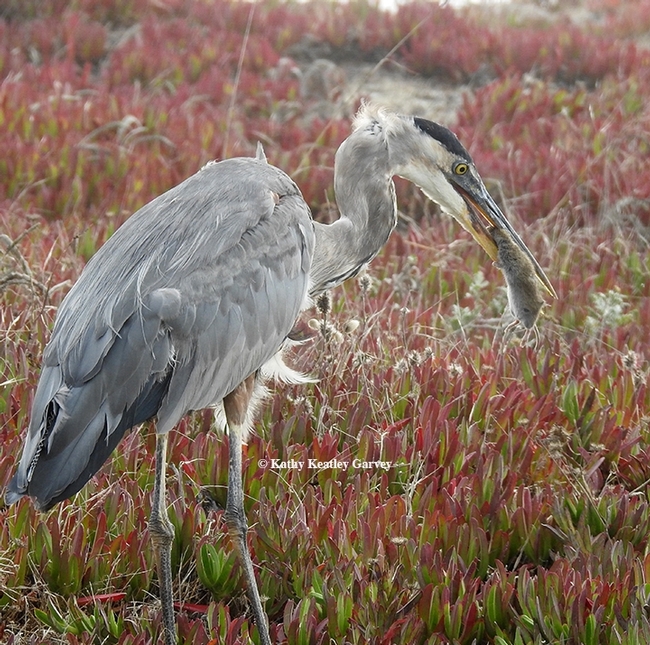
- Author: Kathy Keatley Garvey
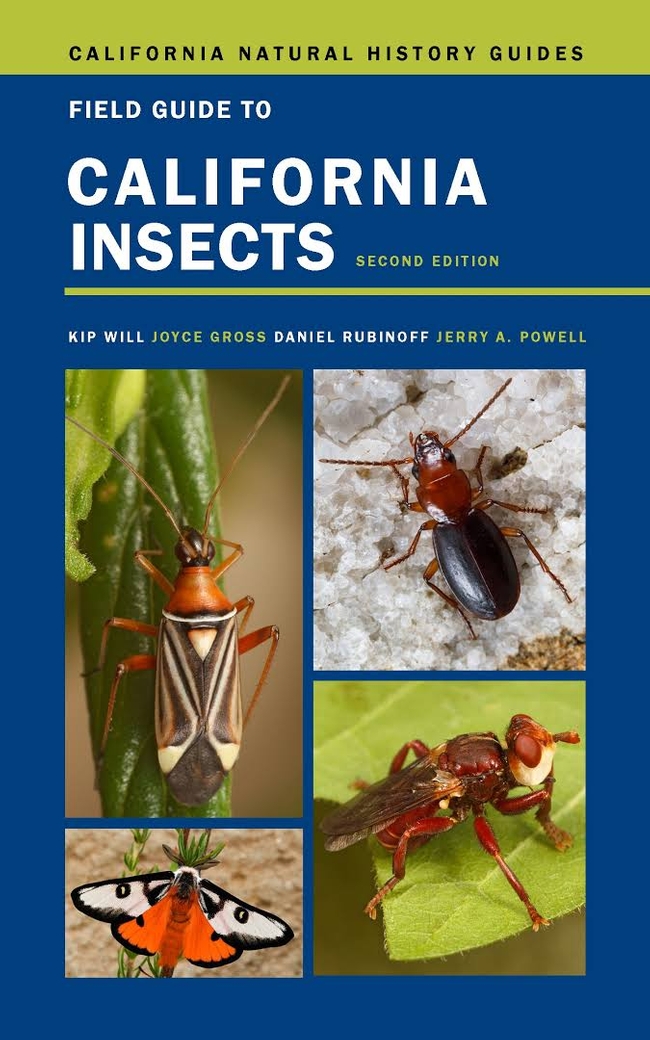
Step into your garden, walk over to a community park, or hike in the wilderness and see what's out there.
And take along the newly published, newly revised "The Field Guide to California Insects."
It includes more than 600 insect species. Not sure what species of butterfly that is? Want to know if that's a Valley carpenter bee? What's that species of praying mantis you just found? Take a look at the text and photos. Chances are you'll find them in this handy book.
It's a California Natural History Guide and published by the University of California Press. If you're into entomology, you'll probably recognize the names of the four authors:
- Kip Will, entomologist, insect systematist, and former director of the Essig Museum of Entomology at UC Berkeley
- Joyce Gross, noted insect photographer (she works as a computer programmer with the Berkeley Natural History Museums at UC Berkeley)
- Dan Rubinoff, who grew up chasing insects in California and is now a professor of entomology and director of the University of Hawaii Insect Museum
- Jerry Powell, emeritus professor, UC Berkeley, and former director of the Essig Museum of Entomology
We remember reading the first edition, California Insects, published in September 1980 and authored by Professor Powell and (the late) Charles Hogue.
So this revision is 40 years in the making.
It's billed as the only California-specific, statewide book devoted to all groups of insects:
"Engaging accounts focus on distinguishing features, remarkable aspects of biology, and geographical distribution in the state. An accessible and compact introduction to identifying, understanding, and appreciating these often unfamiliar and fascinating creatures, this guide covers insects that readers are likely to encounter in homes and natural areas, cities and suburbs, rural lands and wilderness. It also addresses exotic and invasive species and their impact on native plants and animals. Field Guide to California Insects remains the definitive portable reference and a captivating read for beginners as well as avid naturalists."
The authors point out that worldwide, there are only a million described insects, and that's "more than five times the number of all animals combined." They also note that "estimates of the number remaining to be described and named vary between three million to 30 million or more."
Thirty million! Can you imagine?
The authors define what makes an insect, expanding on growth and reproduction, breathing and circulation, feeding and stinging. They write about the distribution and diversity of the California insect fauna; how insects are classified, and even how to make an insect collection, something most high schoolers will be asked to do.
The book offers you information on dragonflies and damselflies, mantises, stick insects, beetles, fleas, flies, mosquitoes, earwigs, moths and butterflies, and booklice--and more.
It's a fantastic book--well-researched, well-written, well-illustrated, and an opportunity for you to become not a Big Game Hunter, but a Little Game Hunter.
By the end of the book, you may even decide to study entomology. (And there's plenty of opportunities in California, including at the UC Davis Department of Entomology and Nematology)
You may also want to become an insect photographer: plant a pollinator garden and they will come. Below are some of the backyard or household images you can capture.
